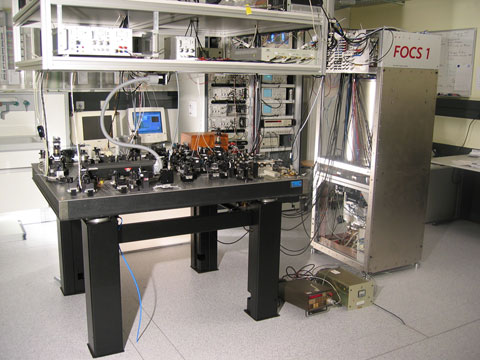Atomic clocks are clock devices that utilize a hyperfine transition frequency that is based upon certain frequencies of atoms as a timekeeping element. Atomic clocks are the most accurate time and frequency standards known, and are used as primary standards for international time distribution services.
Utilizing atomic physics, atomic clock operation are based upon the principles measuring the electromagnetic signals that electrons in atoms emit when they change energy levels. The first to suggest measuring the passage of time using atomic transitions was Lord Kelvin. The development of measuring magnetic resonance in the 1930’s made the measurement of atomic transitions would make this practical. Isidor Rabi would become the first to publicly suggest that atomic beam magnetic resonance might be used as the basis of a clock.[2] The predecessor of NIST was the first to build an atomic clock, as it was less accurate than quartz clocks at the time, but served as a proof of concept. It was at the National Physical Laboratory in the UK that saw the first accurate atomic clock, utilizing transitions of caesium-133 atoms in the 1950’s.
The accuracy of an atomic clock depends on the two factors of atom temperature and the frequency of the transition. The temperature affects the atoms in an atomic clock by having colder atoms move more slowly, which would allow longer probe times of said atoms. The frequency and intrinsic linewidth of the electronic or hyperfine transition are the second factor that helps determine accuracy as the higher frequencies and narrow lines increase the precision of atomic clocks.
Since the beginning of development in the 1950s, atomic clocks have been based on molecules such as hydrogen-1, caesium-133, and rubidium-87. The first commercial atomic clock was the Atomichron, manufactured by the National Company, which was a bulky and expensive instrument. Further developments would replace the Atomichron with smaller rack-mountable devices, such as the Hewlett-Packard model 5060 caesium frequency standard, released in 1964.[1]
August 2004 saw NIST scientists demonstrate a chip-scale atomic clock, which was believed to be the smallest atomic clock on the planet at the time. These researchers said that their new chip-scale atomic clock was believed to be one-hundredth the size of any other and require no more power than a battery could provide. This meant that this technology could be utilized by battery-driven applications, which would became available commercially in 2011. However, it is worth noting that ion trap experimental optical clocks are more precise than the current caesium standard.
In April 2015, NASA announced that it planned to deploy a Deep Space Atomic Clock (DSAC), a miniaturized, ultra-precise mercury-ion atomic clock, into outer space. NASA said that the DSAC would be much more stable than other navigational clocks. We might be taking a look at this Deep Space Atomic Clock in a bit more detail later, so stay tuned!
Applications
Atomic clock development has been incorporated into many scientific and technological gadgets, including but not limited to navigational systems, time radio transmitters and some types of radioastronomy.
Global Navigation Satellite Systems utilize very accurate atomic clocks and several GPS satellites to determine where a person is on the Earth. This is the basis for the entire GPS system as GPS would fall apart without the use of this mechanism.
Time signal radio transmitters are systems that governments utilize to keep precise time. These devices receive radio transmissions on a regular basis to keep the clocks in sync with the accurate time.
Sources And Further Reading
https://www.nasa.gov/feature/jpl/what-is-an-atomic-clock
[1]=M.A. Lombardi; T.P. Heavner; S.R. Jefferts (2007). “NIST Primary Frequency Standards and the Realization of the SI Second” (PDF). Journal of Measurement Science. 2 (4): 74.
[2]=Laurence, William L. (2007). “NIST primary frequency standards and the realization of the SI second” (PDF). NCSLI Measure. 2 (4): 74–89. doi:10.1080/19315775.2007.11721402.

Hi everyone,
I really like your work and your blog is quite interesting.
I have to appreciate your job and efforts.
It is extraordinary.
Kind regards,
Harrell Griffin